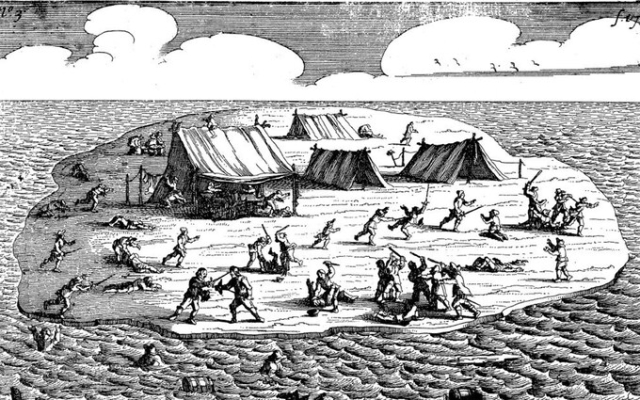 1647 engraving depicting the Beacon Island massacre of shipwreck survivors at Batavia. Photo: Alamy
1647 engraving depicting the Beacon Island massacre of shipwreck survivors at Batavia. Photo: Alamy
On a desert island off the west coast. In the summer of 1629, Australia was in chaos. Opposing each other were several groups of sailors, naval officers, civilians, and their wives and children, all fighting either for vast, almost ludicrous amounts of treasure, or, in many cases, for their lives.
This whole bloody nonsense was led by a failed businessman turned future military leader who saw it as the opportunity of a lifetime, even though he was responsible for an infinite amount of suffering. However, while these factions struggled to outdo each other in bloodshed and treachery, they could never have imagined that centuries later their machinations would lead to the creation of one of the most popular television series of recent years.
The historical events that led to the carnage — and, as we will see, to the BBC hit Traitors — were themselves unprecedented. On October 29, 1628, the Dutch ship Batavia set sail from Texel in North Holland and headed for the Dutch East Indies, more than 7,000 miles away. This was to be a relatively routine trip, the purpose of which was to acquire spices, an extremely valuable and coveted commodity traded by the Dutch version of the East India Company, the so-called VOC, which had established itself as one of the most powerful and wealthy enterprises on earth over the past two decades.
The VOC was much more than just a trading company, and had a range of powers that meant it literally held matters of life and death in its hands. Legally, he could do everything from waging war in other territories (and business) to executing convicts and even creating his own colonies, which would then be financed by the currency he minted himself.
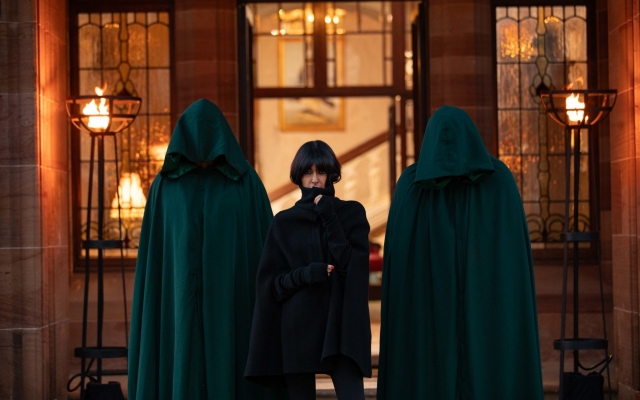 Claudia Winkelmann in Traitors Photo: Mark Mainz/BBC
Claudia Winkelmann in Traitors Photo: Mark Mainz/BBC
It is this mixture of ruthlessness and pragmatism that has earned VOC its reputation as a leading company of the world's spice trade, and its ships were captained by respected sailors and deeply ambitious men who wanted to make a fortune and reputation through these long and dangerous voyages.
Complete a long and dangerous journey safely and you could make your name forever, but there were huge risks, not least the knowledge that in a time before precise maritime measurements, ships could easily be wrecked or veered off course by hundreds of miles. And, just as dangerous, a clash of characters between people driven—some might say blinded—by ambition can lead to uncertain, even fatal, consequences.
It did not help that there was animosity between the fleet commander Francisco Pelsaert, who was in charge of the eight ships of which the Batavia served as flagship, and the Batavia's captain Ariane Jacobs; the two had previously met each other in India two years earlier, at the Dutch trading post of Surat, and an angry Pelsaert humiliatingly berated Jacobs for getting drunk and being disrespectful. Jacobs had not only brooded over this slight since the moment they met, but was determined to take revenge.
He enlisted the help of Pelsaert's second-in-command Hieronymus Cornelis, a former apothecary who was desperate for funds, and offered him a simple solution to their problems. If they could seize control of a ship loaded with vast quantities of gold and silver, they could lead a new carefree existence somewhere thousands of miles from Holland, far from the reach of the VOC. And if Pelsaert and others had to die for this to become a reality, then so be it.
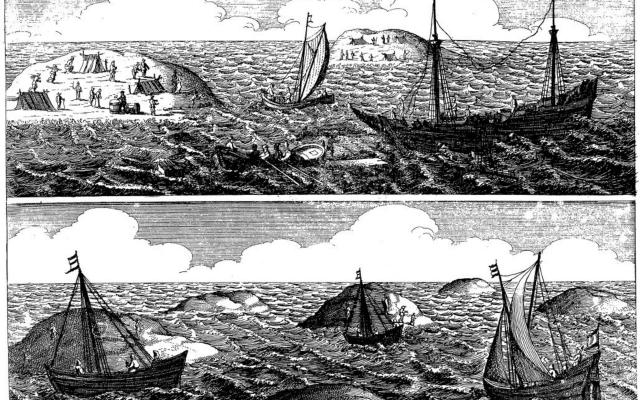 Image from the 1647 Dutch book The Unsuccessful Voyage of the Batavia' Photo: Alamy
Image from the 1647 Dutch book The Unsuccessful Voyage of the Batavia' Photo: Alamy
Cornelis waited until the Batavia had passed the Cape of Good Hope, and then deliberately steered the ship away from the rest of the fleet, and also provoked incidents on board that were designed to show Pelsaert in a worse light, not least by organizing the sexual assault of a passenger. Lucretia Jansz, a merchant's daughter who was traveling to join her husband in the newly formed colony. In total, there were about 340 passengers on board the Batavia: sailors, officers, soldiers and wealthy individuals; the presence of women and children was not unusual, but soon proved explosive.
Given Cornelis' behavior, it was unforeseen but almost inevitable that the Batavia struck the Morning Reef off the coast of Western Australia on 4 June 1629 and was shipwrecked, resulting in the death of many of its passengers. Those who survived were able to travel by longboat to the deserted Houtman Abrolhos Islands, where they, under the leadership of Pelsaert, quickly realized that the lack of potable water and edible food meant that they could not survive for long without help.
Pelsaert decided to take a small, carefully selected crew, including Jacobs, and sail to the ship's original destination—itself called Batavia—in search of rescue and fresh supplies. After a rather hot voyage, they eventually reached safety and were given a new ship, the Sardam, whose mission was to both rescue the survivors remaining on Houtman Abrolhos and, more importantly, the wealth that might have remained on the Batavia. However, when they returned, they could hardly imagine the horrors that followed their absence.
It may seem a strange transition from a tale of 17th century piracy, bloodshed and betrayal to the current hit BBC show Traitors, starring Claudia Winkleman, returning for a second series, but the events that followed on a desert island in Western Australia may seem strange. Originally inspired by the Dutch series De Verraders, which became the basis of the British show. As anyone who's seen the original series knows, the tension and intrigue of Traitors comes from two warring factions, the Loyal and the Traitors, pitted against each other in an attempt to win a cash prize.
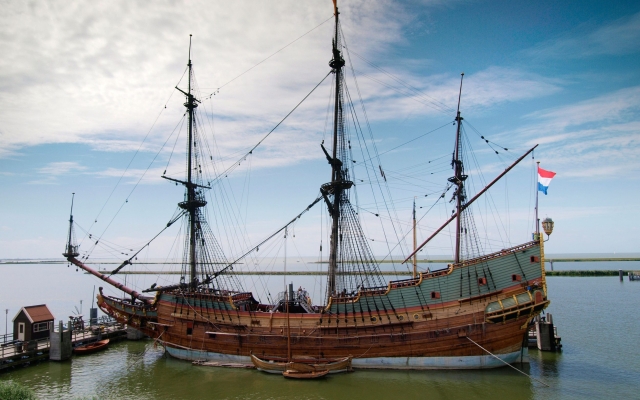 An exact replica of Batavia in the Netherlands. Photo: Alamy
An exact replica of Batavia in the Netherlands. Photo: Alamy
Both the British and Dutch shows are set in a majestic castle, but according to the program's original developer Jasper Hoogendoorn, the original idea was to set it on board a ship and essentially recreate the events in Batavia in 1629, albeit there , where the violence is more psychological than bloody. As Hoogendoorn said at the 2023 Edinburgh TV Festival: “This is a story about people killing each other, stabbing each other in the back, betraying each other. This is a terrible story. But it was such a fascinating story, and I thought it was exciting too. It's so interesting to read this story, and that's where the idea for the show came from.»
Dutch broadcaster RTL did not appreciate the cost that the antics on the ship would entail, so the castle's location was seen as an acceptable compromise. But the idea of two warring factions, irreconcilably vying for wealth, remained — albeit inevitably — in a diluted form.
When Pelsaert and his men abandoned the islands, Cornelis returned to the survivors after a futile attempt to plunder the sunken Batavia for profit. Although he had no military or naval experience, he was able to take control of the remaining men and women, creating a council that convinced the survivors with its authority. However, he quickly realized that with limited supplies there was little chance of keeping everyone alive, and that over time the resentful and angry population of this makeshift colony would turn against him. What he did then was, in its own way, a grotesque stroke of genius.
He divided the survivors into groups, and anyone who posed a potential threat was isolated. These included a group of soldiers led by Wibbe Hayes, who were sent to Wallaby Island under the pretext of finding drinking water and told they would be rescued when they did, but instead found themselves stranded. Cornelis himself retained all the weapons, as well as the food and water they owned, meaning that he now had the power of life and death over everyone. He mainly used the latter.
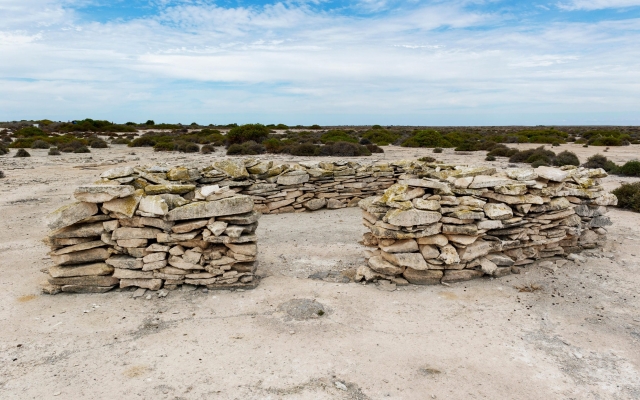 West Wallaby Island fort built by Dutch soldier Wibbe Heys after a shipwreck in Batavia. Photo: Alamy
West Wallaby Island fort built by Dutch soldier Wibbe Heys after a shipwreck in Batavia. Photo: Alamy
Cornelis then convinced many of the survivors that their shipmates had committed crimes such as theft, and that they deserved to be executed for their crimes. In the following days, he ensured that those who might remain loyal to the VOC were either publicly killed or secretly drowned or stabbed to death. The women, including Jans, who was intended for Cornelis's own use, were turned into sex slaves and raped repeatedly.
With the only men who could pose a serious threat to his power in Hayes and the other soldiers exiled without weapons, he began to consider his options, which included hijacking any rescue ship that Pelsaert and his men returned with. killing anyone he deemed disloyal, and eventually founded his own kingdom, paid for with the gold and silver left on Batavia.
He might have succeeded had it not been for the unfortunate fact that Hayes and his fellow military men discovered potable water on Wallaby and were alerted to Cornelis' nefarious activities by his fleeing victims. After they returned to the main settlement, a pitched battle ensued between the two factions, with Cornelis and his men nearly gaining the upper hand before Pelsaert and his men returned aboard the Sardam.
Having assessed the horrors of the situation by Hayes, Pelsaert quickly ordered Cornelis and his assistants hanged on nearby Seal Island, but not before their arms were torn off and most of the other attackers were subsequently tortured to death by brutal methods including pitching. towing and wheel breakage at sea. Jacobs, perhaps surprisingly, escaped this fate by refusing to admit his guilt even under torture, and was believed to have subsequently died in prison.
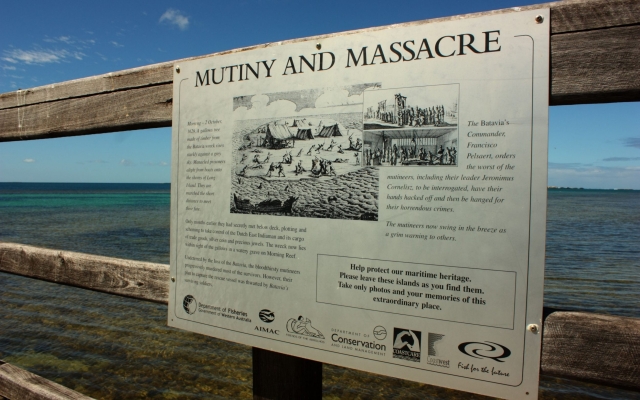 A sign marking the fate of Batavia on East Wallaby Island. Photo: Alamy
A sign marking the fate of Batavia on East Wallaby Island. Photo: Alamy
Although Hayes was promoted and hailed as a hero, Pelsaert was found guilty of the incident and, after being stripped of all his property, died in disgrace within a year. However, from the VOC's perspective, these incidents, although horrific, were not financially devastating; of the 12 boxes of gold and silver with which the Batavia sailed, 10 were found and safely transported back on the Sardam.
These incidents remain a source of grim fascination in Holland and beyond, and demonstrate just how venal and murderous human nature can be, especially where great wealth is involved. They were more or less hushed up at the time and were never spoken of, but fascination with the murderous events of 1629 continued. from the dozen victims of the massacre to the presence of homemade weapons and the remains of the gallows where Cornelis and his fellow criminals were summarily executed, reminds us that this story and its dark legacy continue to linger in the popular imagination.
Sorry, Claudia and others, but Traitors — even in its most incredibly complex form — cannot come close to the real events that lurk in its DNA.


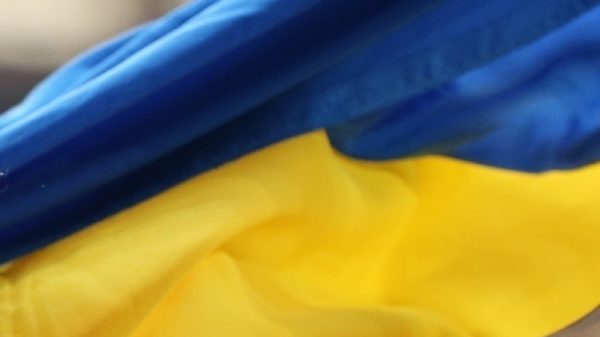








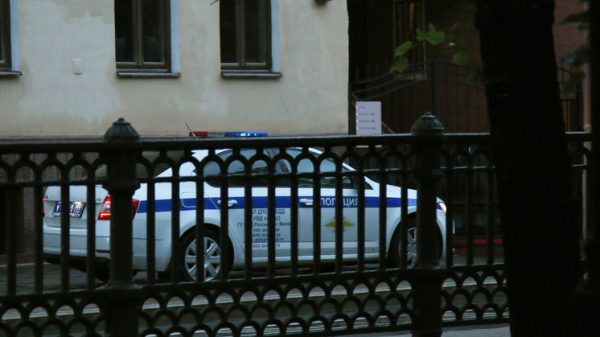

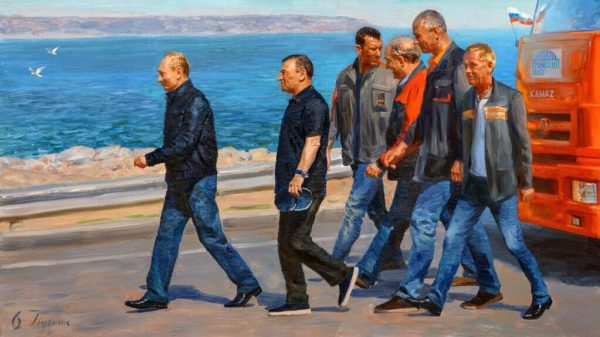
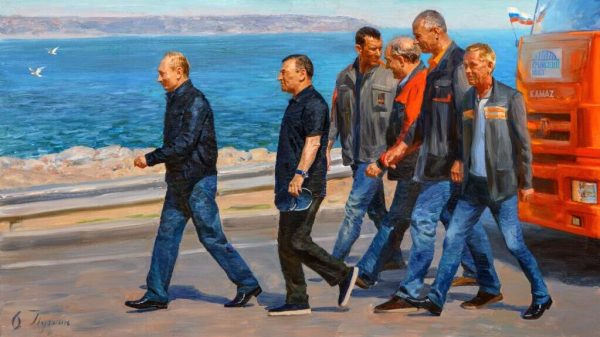

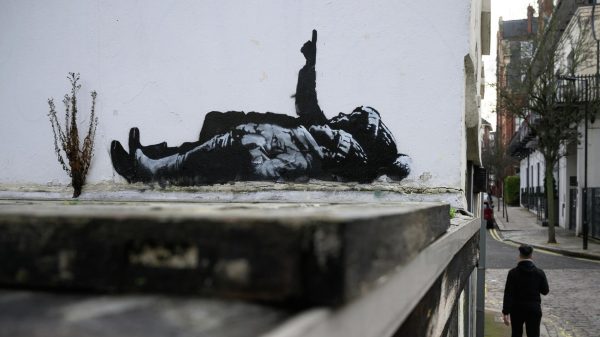





































Свежие комментарии